Steven Lyle Jordan's Blog, page 40
September 24, 2014
Entertainment over issues
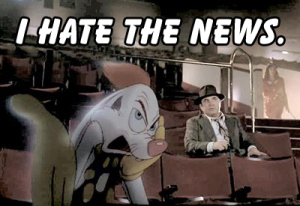 Looking over the stats on this site, it has become abundantly clear that posts related to entertainment—a review of a movie, or discussion about a TV show or trope—do significantly better than posts about science, technology or social issues. Like Roger Rabbit, my readers do not want to read about real world issues; they want to be entertained.
Looking over the stats on this site, it has become abundantly clear that posts related to entertainment—a review of a movie, or discussion about a TV show or trope—do significantly better than posts about science, technology or social issues. Like Roger Rabbit, my readers do not want to read about real world issues; they want to be entertained.
Good to know. I can use that info to make some changes around here, away from news items and science and technology commentary, and toward comments and discussions about shows, movies, etc.
Maybe.
Or I can keep talking about the things I happen to think are significant, from a futurist’s point of view.
Hmm. Tough choice.


September 22, 2014
Snowpiercer: Don’t miss this masterpiece
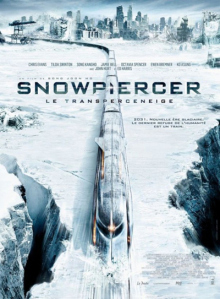 This weekend, I saw the Bong Joon-Ho experience known as Snowpiercer, on hotel pay-per-view. I’d missed its appearance in theaters, so my wife and I were glad to see it in the hotel’s new releases rotation. And we’re so glad we saw this movie.
This weekend, I saw the Bong Joon-Ho experience known as Snowpiercer, on hotel pay-per-view. I’d missed its appearance in theaters, so my wife and I were glad to see it in the hotel’s new releases rotation. And we’re so glad we saw this movie.
First, it must be said that I realize quite a few people probably missed seeing this movie when it came out, just as I did. That’s because the distributor, Harvey Weinstein, wanted to make cuts to the movie and add voiceovers for us poor, moronic, nose-picking U.S. audiences… which director Joon-Ho refused. As a result, Weinstein gave the movie a very limited release, with almost literally no publicity attached (I’d been keeping up with Snowpiercer‘s progress on IO9, and I still managed to miss its release).
But, just like that recently-discovered masterpiece Cloud Atlas, this is one limited release movie that you need to find and watch. (No spoilers ahead: Track is clear.)
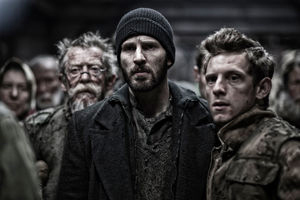 Snowpiercer stars Chris Evans and John Hurt as the leaders of a rebellion, on a train that contains the last of humanity after a science community blunder to fix global warming freezes the planet. The train, equipped to be self-contained and self-sufficient by its inventor and engineer, travels a track that travels a circuit through every continent, literally circumnavigating the globe once every year.
Snowpiercer stars Chris Evans and John Hurt as the leaders of a rebellion, on a train that contains the last of humanity after a science community blunder to fix global warming freezes the planet. The train, equipped to be self-contained and self-sufficient by its inventor and engineer, travels a track that travels a circuit through every continent, literally circumnavigating the globe once every year.
Generally speaking, in science fiction it is recommended to have one incredible concept, one big conceit, and the rest of the science should be straightforward and understandable. Snowpiercer‘s train, rocketing through a permanently frozen Earth with the last of humanity aboard, is this movie’s conceit, while the rest of the technology presented to the viewer is pretty much just what you’d expect to see on a self-sufficient train (albeit very stylishly presented).
On this train, society is broken up in a clearly linear pattern, with the rich living up front, the middle class in the center, and the “wretched refuse” riding the back. And because conditions in the back of the train are so bad, the tail end riders have concocted a way to get to the front of the train and take over the engine by going through stormtrooper-style guards led by Tilda Swinton, playing what can only be described as the social worker from Hell. This oh-so-literal examination of class struggle might seem trite, but Joon-Ho puts some great twists and turns into the story to keep you entertained.
The characters themselves might make those in a Terry Gilliam film seem staid. (In fact, between one of the main characters being named Gilliam, and much of the treatment of characters and look of the film, I found myself thinking of Terry and Brazil more than once.) Certain character traits and mannerisms are wonderfully knitted into the story, and you find out their true meaning much later on, adding an incredible depth to this “linear” story. But where the meanings that come to you in a Gilliam film tend to be for laughs or “Oh cool” moments, Snowpiercer‘s revealed meanings are there for nightmare fuel.
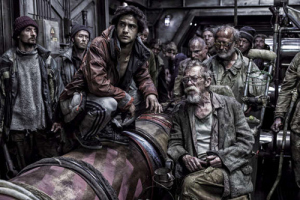 The movie is understandably claustrophobic, especially because there are so few windows on the train; rarely do you have the feeling that you are on a vehicle traveling through the frozen wasteland… except during the few moments when the director wants you to feel exactly that, and presents you with picture windows that allow you to see the frozen wasteland hurtling past. Otherwise, you’re in a linear world, and that’s all there is; much like the planet that we live on, largely heedless of the fact that the Earth itself is careening through the vast and inhospitable galaxy at impossible speeds.
The movie is understandably claustrophobic, especially because there are so few windows on the train; rarely do you have the feeling that you are on a vehicle traveling through the frozen wasteland… except during the few moments when the director wants you to feel exactly that, and presents you with picture windows that allow you to see the frozen wasteland hurtling past. Otherwise, you’re in a linear world, and that’s all there is; much like the planet that we live on, largely heedless of the fact that the Earth itself is careening through the vast and inhospitable galaxy at impossible speeds.
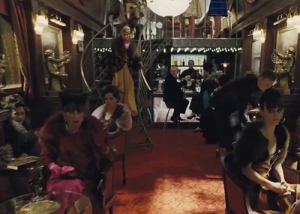 And thanks to the claustrophobic tableau, the activity on this train is very in-your-face, the action right on top of you, the characters’ choices always reduced to the only two directions available—back, and forward. Every character’s situation is equally desperate… even those in the front of the train who eventually see those from the back making their way forward, and stare helplessly back like does caught in a car’s headlights.
And thanks to the claustrophobic tableau, the activity on this train is very in-your-face, the action right on top of you, the characters’ choices always reduced to the only two directions available—back, and forward. Every character’s situation is equally desperate… even those in the front of the train who eventually see those from the back making their way forward, and stare helplessly back like does caught in a car’s headlights.
Snowpiercer is a beautifully-filmed piece (here, I don’t evoke Gilliam, as Joon-Ho’s filmography is much more kinetic and precise than Gilliam’s sense of style, even as it is limited to such small spaces). Everything inside the train looks equally plausible and incredible, especially as you move further through to the front of the train. Whereas the back of the train looks nasty and oppressive, the front looks almost like an engineer’s idea of Heaven in contrast.
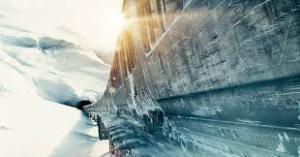 The outside of the train… barely figures into the movie at all, appearing only sparingly, and never in its entirety until the very end. You don’t pause in the middle of a tense police drama to check out an exaggerated beauty shot of the city; and neither does Joon-Ho. The few moments you do see the outside of the train are there to remind you of how insane this trip is, how precarious and at constant risk of catastrophe are the cars and their occupants.
The outside of the train… barely figures into the movie at all, appearing only sparingly, and never in its entirety until the very end. You don’t pause in the middle of a tense police drama to check out an exaggerated beauty shot of the city; and neither does Joon-Ho. The few moments you do see the outside of the train are there to remind you of how insane this trip is, how precarious and at constant risk of catastrophe are the cars and their occupants.
And, of course, the big treat here is that this story is not nearly as “linear” as it seems, its own true meanings revealed at the end. There are some other great reveals throughout the story, with only one expository moment (from Evans) that seems forced and convenient… and sure enough, plays appropriately into the climax. And the ending, while not typical of Hollywood Big Damned Happy Ending blockbusters, may be the only one that would even remotely make sense.
Overall, an incredible movie experience, and a triumph for Bong Joon-Ho, marred only by an admirable sabotage job by Weinstein to keep you from seeing it. Hopefully you did anyway; if not, I urge you to search it out on pay cable, or keep an eye out for the DVD and Blu-Ray releases that just might serve to blow some people’s minds and elevate this movie to instant cult status.
Extra: This video provides a great visual breakdown of Snowpiercer, for you serious Art House fans.


September 17, 2014
“The two types” of writers?

Zadie Smith
I was just linked to an article by Mary Popova on author Zadie Smith, and her comments on the Psychology of the Two Types of Writers. It’s a great read, mainly to gain an understanding of how Zadie herself works, and how she sees the authors who work in a different manner than herself, in creating a novel.
Though I enjoyed the article, I must admit to my own subconscious red flags waving as soon as I saw the title of the piece. Not long after I dived in, I found:
Smith begins by proposing the two psychological profiles into which all writers fall — a dichotomy reminiscent of Italo Calvino’s hedgehog-versus-fox classification system of writerly personalities.
Reading further, I confirmed my own suspicions: That the two psychological profiles that Smith proposes encompasses “all writers”… do not happen to include me.
So, I would respectfully like to submit that there is another, equally valid psychological profile for writers, the profile which does, in fact, encompass writers like me: That of the Craftsman.
There is a reasonable amount of space between Zadie’s archetypes, the Macro Planner and the Micro Manager—that is, between the writer obsessed with pages and pages of notes, thorough and detailed outlining, often starting at any point in the story and working backwards, forwards, up, down and sideways, multiple-editing and revising, and choosing between multiple endings depending on their mood of the day—and the writer who sits down, writes the first words, and thereafter goes into some sort of a zen-like creative trance, not to exit until the last words come out. (These are my words, not Zadie’s, but they somewhat glibly sum up my impression of both types.)
Zadie counts herself as being the latter type of writer… what I, personally, tend to call “Arr-teests” with a significant show of teeth upon pronunciation… and she admits to not being able to fully understand the former, whom, I imagine, she sees as sucking much of the creativity out of the writing process (and who, most likely, would similarly consider her a flake).
But there is room between these two archetypes for the writer who is comfortable within their craft… who is capable of advanced planning, knowing at the beginning essentially what their work will yield, but leaving it up to their relative skills, and a bit of serendipity, to guide the final shape of the work.
This is the Craftsman. Compared to the Craftsman, I would liken the other archetypes as being akin to an Engineer—uber-precise—and a Sculptor—guided by their muse. The Craftsman neither worries about being precise, nor allows pure artistry to guide them; they know what they want to create, and that’s what they create.
 In the past, I’ve compared the kind of work I do to that of a carpenter creating a chair. A carpenter making a chair knows the basic structure of a chair, so he will decide what kind of chair he wants to make, collect the appropriate materials for it, and apply his skills to the familiar steps of making that chair. He may be making a simple dining room chair, an ornate living room chair, or a Throne of Swords, but he trusts in his innate knowledge of woodwork/metalworking/upholstery to make that chair.
In the past, I’ve compared the kind of work I do to that of a carpenter creating a chair. A carpenter making a chair knows the basic structure of a chair, so he will decide what kind of chair he wants to make, collect the appropriate materials for it, and apply his skills to the familiar steps of making that chair. He may be making a simple dining room chair, an ornate living room chair, or a Throne of Swords, but he trusts in his innate knowledge of woodwork/metalworking/upholstery to make that chair.
When I create a story, I decide at the beginning what kind of story I want to write. I take notes, not heavily detailed, but enough to keep me on track , to make sure I remember aspects about the characters and settings that I consider most pertinent to the story overall. I outline the story, from start to finish, so I know what’s supposed to happen at every story point. I make any changes to the story or characters in that outline—again, nothing heavily detailed, but just enough to make clear what I want to do.
Once that’s done, I start writing, from the beginning. Following the outline and occasionally double-checking my notes, I trust to my wordsmithing skills to come up with the words I need to describe each moment, to flesh out a character, to create powerful dialogue, to illustrate a moment. I don’t need to fret obsessively over my words; I know what I want to bring across to the audience, and the appropriate words and phrases just come naturally. My knowledge of the writing process allows me to keep working, or to stop comfortably at any time, and come right back to where I left off without a break in flow; to break the story where it needs to be broken; to monitor the pace and energy; to edit as I go to fix typos, grammatical glitches or sentence structure; and to end the story where it is supposed to end.
When I’m done, I have a product that is carefully crafted from my original intent and design, executed with the quality of my craft, and able to stand up against any other product, whether engineered from a dozen moleskines or created while under a trance. When I’m done, I know I’m done, and I’m confident to show that book to anyone at that point.
The work of a craftsman isn’t overly dramatic, ornate or miraculous; it’s quite literally a product of his innate experience, skill, care and patience. And if he’s a good craftsman, his work should stand up against the most incredible works produced by engineers or artists… not as a highly-engineered work, or a fine sculpture, but as a considered and well-made creation, built to do exactly what it does, and do it well, made by someone who knows his trade inside and out.
So, that is the best description of myself as a writer: The confident and capable craftsman, and one who (I’m not ashamed to point out) has turned out sixteen novels in the past two decades. This is no reflection on the profiles Zadie has outlined, nor a claim that my profile is better than hers or any other; just that it exists, and it’s as significant as those profiles she describes. And another area where Zadie and I differ, is that I do not assume that these three profiles are the only profiles that fit a writer—I believe that there are certainly many more profiles, many more reasons, and many more kinds of people who write, and could describe their own profile at least as well as I have mine.
Perhaps some authors (or readers) would read this, and decide that my work was somehow inferior to others’ without all the histrionics applied therein. I would point out that this world is full of writers who are capable of writing without histrionics, and produce high-quality, award-winning and consumer-beloved material on a regular basis. I would point out that there is plenty of room in this world for the Craftsman, the people who know their skills and apply them to their craft, confident of what will come out at the end. I would also point out that there’s little value in an artist’s muse-guided conception of a chair, or an engineer’s construction of same… that no one would be comfortable sitting in.
And that, dear reader (all six or so of you) is what’s really important: Not what kind of writer I am; but whether or not anyone bothers to read my work. It doesn’t matter whether I’m a Craftsman, a Planner or a Manager. Only readers matter. Without readers, I’m someone who wastes a lot of time in pointless effort with no reason or reward. I might as well be spending my evenings drinking myself into a stupor (and I’d be about as satisfied with my efforts come the morning). Without readers, all of us writers are just spinning our tiny, squeaky wheels.


September 15, 2014
James Burke’s Connections: We need more of this
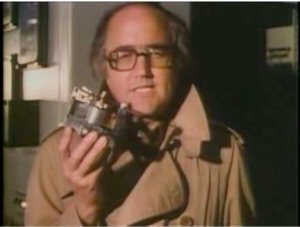
Historian and futurist James Burke
No one who spends their time thinking about the technological possibilities of the future should do so, without thinking deeply upon the observations of historian James Burke. Burke gave us a way of looking at our technological history that opened our eyes to the incredibly, naturally non-linear nature of human science, technology and invention that should never be forgotten or taken for granted. James Burke, through his book and TV series Connections, showed us how the world really works.
When I was first introduced to Connections, I was in college, taking a course in the History of Technology. I was immediately fascinated to discover that the class would be working from the book, Connections, along with filmed chapters of the book’s material, one for each chapter, and narrated by the same man who’d written the book. A book and matching TV show: What a concept! (Hey, it was 1978. Climb off.)
Even better than that media coup, was James Burke himself. Burke had carefully studied technological history, had discovered how progress really happened in this world, and used his book and series to present the real world to us, in a wonderfully engaging way.
Using clever personal narration, well-planned camera work and visuals, and quality historical reenactments, he showed us a world in which technological development was not a clean, linear process—that is, a need for transportation leads to the creation of the car, which leads to improvements in engine technology, which leads to improvements in gasoline refinery, etc—but a series of unpredictable connections, often by developments in technology that caused a change in culture and thereby a change in living priorities, which led to a development in another discipline altogether… or developments in one area that another inventor realized would solve a completely different problem in another area. For instance, that the automobile carburetor was inspired by a medical device, an atomizer… while the cylinder’s ignition mechanism was taken from a device designed to measure swamp gas. These developments could also sever possible connections, such as people whose expected futures were altered by a change in technological development, forcing their technological development to change focus or location, or cease altogether.
Burke’s overall lesson was that invention was random, much different than following a predictable set of steps to achieve a predetermined goal… the way most people tend to think of technological development. In Burke’s view, any series of steps could have easily been altered, and given us almost inconceivable changes to the way we live, work, play, travel, eat, stay healthy or communicate… and even more inconceivable changes to disciplines we can’t even think of.
Burke had a way with the camera, being fully capable of telling funny, serious and compelling stories about the people and events of our past; delivering his lesson’s point, or punchline; and quickly moving on, while the point was still fresh. His enthusiasm for the wonders of technology was equally plain, giving him the gravitas to match another great televised teacher, Carl Sagan, and his enthusiasm for science. In short, you could watch this cool guy all day long.
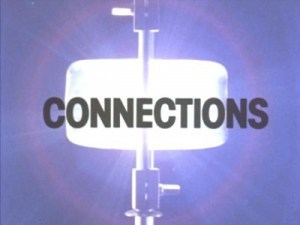 Connections turned out to be so popular, in schools and on television, that it spawned new series (really, reboots of most of his original material, along with some new technological elements that had become significant since the 70s): Connections2, and The Day the Universe Changed. And in 1989, Burke used his understanding of the past to create After the Warming, an examination of how human history had been impacted by climate change over the past few thousand years, with additional conjecture on how continued global warming will likely impact our near future.
Connections turned out to be so popular, in schools and on television, that it spawned new series (really, reboots of most of his original material, along with some new technological elements that had become significant since the 70s): Connections2, and The Day the Universe Changed. And in 1989, Burke used his understanding of the past to create After the Warming, an examination of how human history had been impacted by climate change over the past few thousand years, with additional conjecture on how continued global warming will likely impact our near future.
James Burke’s observations should be foremost in the mind of anyone trying to divine the future of technology, and how related and seemingly unrelated elements can impact future development. I’ve applied his lessons myself, most notably in Sarcology, Chasing the Light and As the Mirror Cracks to develop a future that feels more authentic, grounded and possible.
In an era that seems to desperately need scientists and scholars who can readily communicate the awe and wonder of science and technology… an era where the likes of Neil DeGrasse Tyson and Bill Nye have to fight to capture the minds of students, other “science personalities” on TV come off as too artificially smug about their own credentials to warm up an audience, and “science education shows” tend to be much more polished than they are engaging… we need more people like James Burke. Connections, and Burke’s later programs, stand alongside both the new and original Cosmos as among the most powerful and valuable teaching tools for our future scientists, technologists and inventors. We need more Connections, and more people to show us the truth about science, and about ourselves.


September 7, 2014
Trying Draft2Digital, and a discounted price
 I’m taking the advice of a fellow author and trying out the services of Draft2Digital to sell my ebooks. I’ve chosen one book to try the service out—The Kestral Voyages: My Life, After Berserker. And I’m also going to experiment with a significantly lower price point, since my books weren’t selling at $4.99; My Life, After Berserker has been re-priced at $1.99. (Except at Amazon, which would not accept a price lower than $2.99.)
I’m taking the advice of a fellow author and trying out the services of Draft2Digital to sell my ebooks. I’ve chosen one book to try the service out—The Kestral Voyages: My Life, After Berserker. And I’m also going to experiment with a significantly lower price point, since my books weren’t selling at $4.99; My Life, After Berserker has been re-priced at $1.99. (Except at Amazon, which would not accept a price lower than $2.99.)
My hope is to pick up more of an international audience by going outside of Amazon and Barnes & Noble books. When I first started out, I sold books directly from my site in multiple formats; but I never managed significant sales there, and I suspected it was because there wasn’t enough trust inherent in a small website like mine, not to mention the PayPal payment interface that non-US purchasers apparently didn’t trust. Eventually, I closed the store, to rely exclusively on Amazon and Barnes & Noble.
In recent years I’d done interviews and traded posts with Book Chums, an Indian books site, and again it made me reconsider my potential international audience. I’d tried Kobo a while back, but I really wasn’t happy with the interface or the result. But as I knew Amazon covered many international markets, I decided I could wait for a more satisfying experience.
In Draft2Digital, I may have found that better experience. They offer an easy-to-use publishing interface, converting my Word docx files into epub and pdf (I’ve opted out of Kindle for now, since my books are already in there). The process was fairly painless, and the epub and pdf downloads of my book looked pretty good, first time. After a review, I published the book… and it was available within 6 hours on the distribution sites I’d chosen.
It’s already available at Kobo, Inktera and Scribd, for anyone who’s interested (or wants to pass on the word about a great book at a great price to their friends). Depending on how well sales go, I’ll decide how many more of my books I’ll upload to D2D.


September 4, 2014
Why no female superheroes? Fear.
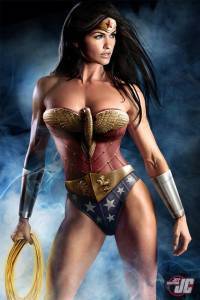 A recent blog post by Sue Archer flags this popular issue: Thanks to years now of excellent and popular superhero movies, the fan world has been rearing up and calling out the obvious missing piece of the franchise puzzle: Why no female superhero movies yet? Warner Brothers (who owns the DC Comics superheroes) has been held up to the light for producing Superman, Batman and Green Lantern for cinema, and a number of other male heroes for television, but not Wonder Woman. And Marvel, seemingly doing no wrong with its superhero line-up, has so far passed on super-powered female heroes like Captain Marvel.
A recent blog post by Sue Archer flags this popular issue: Thanks to years now of excellent and popular superhero movies, the fan world has been rearing up and calling out the obvious missing piece of the franchise puzzle: Why no female superhero movies yet? Warner Brothers (who owns the DC Comics superheroes) has been held up to the light for producing Superman, Batman and Green Lantern for cinema, and a number of other male heroes for television, but not Wonder Woman. And Marvel, seemingly doing no wrong with its superhero line-up, has so far passed on super-powered female heroes like Captain Marvel.
One begins to suspect a conspiracy… which, of course, is what the web has pounced on. Everyone wants to know what’s going on here.
Naturally, I believe I know what’s happening.
I think they’re scared.
I think that, on a real level, they are just plain afraid of female superheroes… and I don’t mean from a masculine standpoint. I think it comes from a fear of inciting negative reactions from any part of their audience. They are afraid of ticking off the ticket-buyers, their real bread-and-butter, by upsetting their sensibilities.
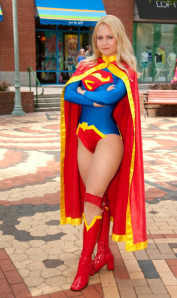 Consider: Female superhero costumes tend to be hyper-sexualized… light and tight spandex, bared arms and legs, and all to be put those buff bodies on display during insane acrobatics, melodramatic poses and wrestlemania moments that have no prayer of being defined as anything but regularly and distinctly gratuitous. Sexy girls in body-revealing outfits, getting into cat-fights and punch-ups? That won’t be looked at kindly in the anti-neanderthal atmosphere that men habitually have to wade through today. And then there’s the threat: If a woman is even temporarily defeated… beaten… or (gasp!) restrained… especially by a power-hungry, domineering man (pronounced “May-an” by the DAR)… what kind of feminist backlash will there be on that?
Consider: Female superhero costumes tend to be hyper-sexualized… light and tight spandex, bared arms and legs, and all to be put those buff bodies on display during insane acrobatics, melodramatic poses and wrestlemania moments that have no prayer of being defined as anything but regularly and distinctly gratuitous. Sexy girls in body-revealing outfits, getting into cat-fights and punch-ups? That won’t be looked at kindly in the anti-neanderthal atmosphere that men habitually have to wade through today. And then there’s the threat: If a woman is even temporarily defeated… beaten… or (gasp!) restrained… especially by a power-hungry, domineering man (pronounced “May-an” by the DAR)… what kind of feminist backlash will there be on that?
So they tiptoe around the issue, and when they capitulate, the public gets weak fare like Catwoman… mostly a result of sad writing and production designed to give a sexy actress a movie vehicle whilst simultaneously avoiding scaring the people whose opinions sway the masses.
Today, both studios are willing to admit that they’re thinking on it… but neither has actually started to work on any female superhero films. Warner even started a Wonder Woman production, penned by the same Joss Whedon who gave Marvel The Avengers… and Warner rejected it. (Actually, DC/Warner did give us Birds of Prey, a team of female heroes—and they tried to bring Wonder Woman back to television, however troubled the attempt—so people really should give them a little slack.)
I’d be willing to bet that a great deal of the apprehension comes from a concern of making these super-powered ladies somehow less threatening, but not in a way that suggests they have less power than men… the desire to “soften” them, but not make them stupid or campy… making sure any threats posed to them don’t push any psychological or sociological buttons… and finally, to try to make people believe garishly-costumed cheerleaders can hurt big armed thugs.
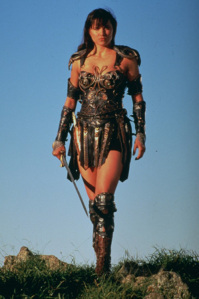 Unfortunately, that same male-dominated movie industry is very conservative, and incredibly myopic, when it comes to their perception of their own audience… even to the point of ignoring their own stats, following 50-year-old tropes and attitudes, and somehow not noticing that the popularity of TV characters like Cara Thrace, Xena, Dana Scully, Zoe Washburn and Samantha Carter did not come from soap opera romance storylines. Even movies like Salt and the Lara Croft movies ably demonstrate that female heroes work and make money. The problem requires thinking outside of the doily-lined box that the executives seem to have their heads stuck in.
Unfortunately, that same male-dominated movie industry is very conservative, and incredibly myopic, when it comes to their perception of their own audience… even to the point of ignoring their own stats, following 50-year-old tropes and attitudes, and somehow not noticing that the popularity of TV characters like Cara Thrace, Xena, Dana Scully, Zoe Washburn and Samantha Carter did not come from soap opera romance storylines. Even movies like Salt and the Lara Croft movies ably demonstrate that female heroes work and make money. The problem requires thinking outside of the doily-lined box that the executives seem to have their heads stuck in.
Hopefully better heads will prevail soon, they’ll get over their fears and obsolete attitudes, and be able to give us female superhero movies with teeth in them. And personally, I’d rather wait for them to do it right than get Catwoman 2: The Electric Boogaloo.


September 3, 2014
Can This Transform the Caribbean?
 Originally posted on Nick Robson's Blog:
Originally posted on Nick Robson's Blog:
In the immortal words of Montserratian singer/songwriter, Arrow, the Caribbean is “…feelin’ hot, hot, hot!” And, that’s agoodthing.

With a little help from Mother Nature, the islands of the Caribbean are learning to harness the power of high temperature geothermal energy beneath the earth’s surface.
In an effort to move away from reliance on expensive, fossil-fueled, diesel-powered generators toward a dependable, eco-friendly source of renewable energy, a number of forward-thinking Caribbean islands are aggressively searching for and identifying alternative sources of power beneath the surface.
Energy self-sufficiency, long sought-after by local governments may soon become a reality for some islands in the Caribbean.
While the road to sustainable geothermal power generation has no short cuts and faces a number of financial, administrative and physical challenges, the rewards can be substantial in the long-run.
Geothermal power produces an environmentally-friendly, long-lasting energy source that can provide electricity at significantly lower…
View original 400 more words


September 2, 2014
Congrats to the 2014 Alien August winner!
Congratulations to John Reiher, whose entry into the SciFi Ideas.com Alien August contest, the Kutalii, beat a tough bunch of excellent entries (including one of my own) for imaginative alien species.
Winging its way down the InterTubes is a copy of my novel Worldfarm One, as part of his winnings. Enjoy, John! And to all the runners-up: Better luck in 2015!


August 30, 2014
No more hiding behind aliases
 I’ve decided to ditch the alias I’ve been using on Kinja pages (like IO9) and Tor.com and start using my real name.
I’ve decided to ditch the alias I’ve been using on Kinja pages (like IO9) and Tor.com and start using my real name.
Fake names and aliases tend to inspire people to do and say things they wouldn’t do or say when people know who they are. People also don’t take you seriously when you hide behind an alias. This simple fact is the cause of most of the angst, trolling and attacks that take place on the web; and although I always tried to hold myself to a higher standard, I don’t want to function as a part of the coward’s internet. If I’m going to speak, people are going know who’s speaking. Even on Kinja.


August 28, 2014
Memento mori.
 Madeline Ashby titles her blog as “Dangerous to those who profit from the way things are.” I got news for Madeline: This article is no better for those of us who can’t manage to profit from the way things are.
Madeline Ashby titles her blog as “Dangerous to those who profit from the way things are.” I got news for Madeline: This article is no better for those of us who can’t manage to profit from the way things are.
This is me all over: I write the kind of SF that I enjoyed reading when I was younger. Today’s kids couldn’t care less about my dreams, though… so the books don’t get bought. I guess if I can’t learn how to write about YA dystopias, I might as well finance my retirement with a pushbroom.
Memento mori. (Or, how Worldcon’s youth problem will resolve.)






